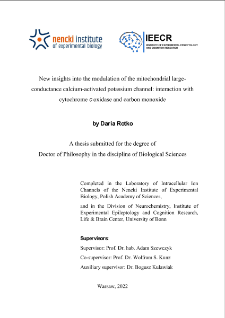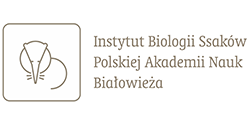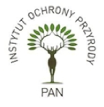- Search in all Repository
- Literature and maps
- Archeology
- Mills database
- Natural sciences
Advanced search
Advanced search
Advanced search
Advanced search
Advanced search

Object
Title: New insights into the modulation of the mitochondrial large-conductance calcium-activated potassium channel : interaction with cytochrome c oxidase and carbon monoxide : PhD thesis
Institutional creator:
Instytut Biologii Doświadczalnej im. Marcelego Nenckiego PAN ; Universität Bonn
Contributor:
Szewczyk, Adam (1960- ) : Supervisor ; Kunz, Wolfram S. : Supervisor ; Kulawiak, Bogusz : Assistant supervisor
Publisher:
Nencki Institute of Experimental Biology PAS
Place of publishing:
Description:
165 pages : illustrations ; 30 cm ; Bibliography ; Summmary in Polish
Degree name:
Degree discipline :
Degree grantor:
Nencki Institute of Experimental Biology PAS ; degree obtained: 09.12.2022
Type of object:
Abstract:
The defining property of mitochondria – generation of mitochondrial membrane potential –interlinks the metabolic and signaling functions of this organelle. Mitochondrial large- conductance calcium-activated potassium channels (mitoBK) execute its fine regulation by allowing the controlled influx of potassium ions into the mitochondrial matrix. This functionendows them with unique properties, resulting in a cytoprotective phenomenon of mitoBKactivation in ischemia-reperfusion injury. The functional and structural interaction of mitoBKchannels with the electron transfer chain, and in particular, its terminal enzyme cytochrome c oxidase (COX), can be one of its molecular mechanisms.To investigate the interaction between the COX and mitoBK channels, different COX-deficientcellular models were employed. Specifically, human astrocytoma cells were depleted ofmitochondrial DNA (mtDNA) by the treatment with 2’,3’-dideoxycytidine. The comparison ofthe protein complexes formed by the mitoBK and COX in the mtDNA-depleted and WTastrocytoma cells identified the interaction of the pore-forming mitoBK subunit with the COX-containing complexes and respirasomes. Furthermore, downregulation of mitoBK-α subunits on both protein and mRNA levels occurred upon mtDNA-induced COX deficiency. Theanalysis of the retrograde signaling pathways induced by the mtDNA depletion in the mtDNA-depleted astrocytoma cells showed activation of the integrated stress response signaling.Human dermal fibroblasts with a mutation in the structural COX subunit – COX8A – were usedas another cellular model with a deficiency in COX. The organization of the electron transportchain was characterized in the COX8A-deficient fibroblasts and HEK293T cells with CRISPR/Cas9 induced mutations in COX8A and ensuing COX deficiency, identifying that theresidual COX was stabilized in the respirasomes. The decrease in the protein amount of mitoBKpore-forming subunit, as well as its protein complexes, was observed.To follow the systemic implications of this coupling, the effect of a gaseous transmitter carbonmonoxide (CO), putatively targeting both COX and mitoBK, was assessed in the patch-clampstudies. While direct application of CO-saturated solution has not exerted significantmodulation of the mitoBK channel activity, patch perfusion with CO-releasing moleculesinduced pleiotropic effects. Perfusion with heme and hemin inhibited mitoBK channels. Thesubsequent application of CO-saturated solution released this inhibition, activating mitoBKchannels in the presence of heme
Detailed Resource Type:
Resource Identifier:
Source:
Language:
Language of abstract:
Rights:
Terms of use:
Copyright-protected material. May be used within the limits of statutory user freedoms
Copyright holder:
Publication made available with the written permission of the author
Digitizing institution:
Nencki Institute of Experimental Biology of the Polish Academy of Sciences
Original in:
Library of the Nencki Institute of Experimental Biology PAS
Access:
Object collections:
- Digital Repository of Scientific Institutes > Partners' collections > Nencki Institute of Experimental Biology PAS
- Digital Repository of Scientific Institutes > Partners' collections > Nencki Institute of Experimental Biology PAS > Dissertations
- Digital Repository of Scientific Institutes > Partners' collections > Nencki Institute of Experimental Biology PAS > Dissertations > PhD Thesis
- Digital Repository of Scientific Institutes > Literature
- Digital Repository of Scientific Institutes > Literature > Thesis
Last modified:
Dec 17, 2024
In our library since:
Oct 20, 2022
Number of object content downloads / hits:
256
All available object's versions:
https://rcin.org.pl./publication/272928
Show description in RDF format:
Show description in RDFa format:
Show description in OAI-PMH format:
Objects Similar
Sęk, Aleksandra
Krajewska, Milena.
Konopacki, M. [Mieczysław]
Wołosiewicz, Marcin
Piecyk, Karolina
Prill, Monika

 INSTYTUT ARCHEOLOGII I ETNOLOGII POLSKIEJ AKADEMII NAUK
INSTYTUT ARCHEOLOGII I ETNOLOGII POLSKIEJ AKADEMII NAUK
 INSTYTUT BADAŃ LITERACKICH POLSKIEJ AKADEMII NAUK
INSTYTUT BADAŃ LITERACKICH POLSKIEJ AKADEMII NAUK
 INSTYTUT BADAWCZY LEŚNICTWA
INSTYTUT BADAWCZY LEŚNICTWA
 INSTYTUT BIOLOGII DOŚWIADCZALNEJ IM. MARCELEGO NENCKIEGO POLSKIEJ AKADEMII NAUK
INSTYTUT BIOLOGII DOŚWIADCZALNEJ IM. MARCELEGO NENCKIEGO POLSKIEJ AKADEMII NAUK
 INSTYTUT BIOLOGII SSAKÓW POLSKIEJ AKADEMII NAUK
INSTYTUT BIOLOGII SSAKÓW POLSKIEJ AKADEMII NAUK
 INSTYTUT CHEMII FIZYCZNEJ PAN
INSTYTUT CHEMII FIZYCZNEJ PAN
 INSTYTUT CHEMII ORGANICZNEJ PAN
INSTYTUT CHEMII ORGANICZNEJ PAN
 INSTYTUT FILOZOFII I SOCJOLOGII PAN
INSTYTUT FILOZOFII I SOCJOLOGII PAN
 INSTYTUT GEOGRAFII I PRZESTRZENNEGO ZAGOSPODAROWANIA PAN
INSTYTUT GEOGRAFII I PRZESTRZENNEGO ZAGOSPODAROWANIA PAN
 INSTYTUT HISTORII im. TADEUSZA MANTEUFFLA POLSKIEJ AKADEMII NAUK
INSTYTUT HISTORII im. TADEUSZA MANTEUFFLA POLSKIEJ AKADEMII NAUK
 INSTYTUT JĘZYKA POLSKIEGO POLSKIEJ AKADEMII NAUK
INSTYTUT JĘZYKA POLSKIEGO POLSKIEJ AKADEMII NAUK
 INSTYTUT MATEMATYCZNY PAN
INSTYTUT MATEMATYCZNY PAN
 INSTYTUT MEDYCYNY DOŚWIADCZALNEJ I KLINICZNEJ IM.MIROSŁAWA MOSSAKOWSKIEGO POLSKIEJ AKADEMII NAUK
INSTYTUT MEDYCYNY DOŚWIADCZALNEJ I KLINICZNEJ IM.MIROSŁAWA MOSSAKOWSKIEGO POLSKIEJ AKADEMII NAUK
 INSTYTUT PODSTAWOWYCH PROBLEMÓW TECHNIKI PAN
INSTYTUT PODSTAWOWYCH PROBLEMÓW TECHNIKI PAN
 INSTYTUT SLAWISTYKI PAN
INSTYTUT SLAWISTYKI PAN
 SIEĆ BADAWCZA ŁUKASIEWICZ - INSTYTUT TECHNOLOGII MATERIAŁÓW ELEKTRONICZNYCH
SIEĆ BADAWCZA ŁUKASIEWICZ - INSTYTUT TECHNOLOGII MATERIAŁÓW ELEKTRONICZNYCH
 MUZEUM I INSTYTUT ZOOLOGII POLSKIEJ AKADEMII NAUK
MUZEUM I INSTYTUT ZOOLOGII POLSKIEJ AKADEMII NAUK
 INSTYTUT BADAŃ SYSTEMOWYCH PAN
INSTYTUT BADAŃ SYSTEMOWYCH PAN
 INSTYTUT BOTANIKI IM. WŁADYSŁAWA SZAFERA POLSKIEJ AKADEMII NAUK
INSTYTUT BOTANIKI IM. WŁADYSŁAWA SZAFERA POLSKIEJ AKADEMII NAUK




































